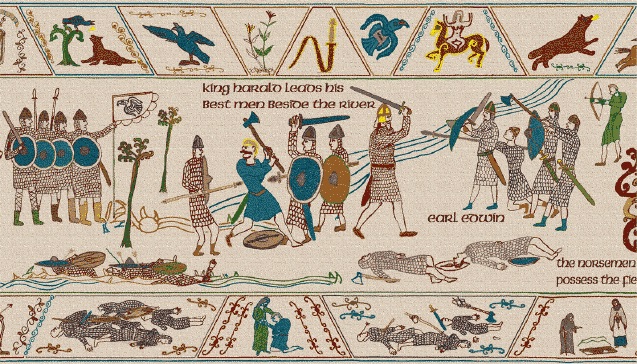The Battle of Fulford
- 20thSeptember 1066 –
The Norman invasion is a pivotal and much studied event in European history. Many have heard the story of Harold Godwinson attempting to defend England from invasions on two fronts, Harald Hardrada (Harald III of Norway) from the North, and William of Normandy from the South. Yet a key event often glossed over, if talked about at all, is the Battle of Fulford, or as it is sometimes called, the Battle of Fulford Gate. It was after this that Godwinson was forced to journey, at incredible pace, to Stamford Bridge and then back again. The Battle of Fulford has shaped history as much as the succeeding battle, fought less than a week later, managed to.
 Fulford was fought by the brothers Edwin and Morcar, Earls of Mercia and Northumbria respectively, against Harald Hardrada accompanied by Tostig, brother of Harold Godwinson. After their exile by Edward the Confessor in 1051 and reinstatement the following year, the Godwin family were the most powerful in the country. Harold, after his father’s sudden death in 1053 became Earl of Wessex and Tostig helped into the Earldom of Northumbria. However, Tostig was extremely unpopular for many reasons; his heavy-handed justice, numerous murders of key figures in important Northern families, the social difficulties of a southerner ruling in the North and his use of mercenaries. All this led to the uprising of many Northumbrians against him and his eventual banishment.
Fulford was fought by the brothers Edwin and Morcar, Earls of Mercia and Northumbria respectively, against Harald Hardrada accompanied by Tostig, brother of Harold Godwinson. After their exile by Edward the Confessor in 1051 and reinstatement the following year, the Godwin family were the most powerful in the country. Harold, after his father’s sudden death in 1053 became Earl of Wessex and Tostig helped into the Earldom of Northumbria. However, Tostig was extremely unpopular for many reasons; his heavy-handed justice, numerous murders of key figures in important Northern families, the social difficulties of a southerner ruling in the North and his use of mercenaries. All this led to the uprising of many Northumbrians against him and his eventual banishment.
After Tostig’s banishment the Earldom of Northumbria was given to Morcar. Tostig himself contacted Hardrada and successfully persuaded him to invade England; Hardrada also had claims to the English throne though the bloodline of the old Viking Kings. Tostig would be useful for Harald as he not only knew the terrain of England, he was the brother of the King.
The invasion commenced and Hardrada, reinforced by Tostig, landed at the mouth of the River Humber on September 18th. The Viking army moved north toward York, the brothers Morcar and Edwin south towards the invaders. The English moved to an area with the River Ouse on the right and swampland on the left. This had the disadvantages of an almost impassable retreat path. It also added the extra danger of one flank being almost indefensible if the other flank collapsed. The Norwegian invaders were organised with the weaker forces on the right and the stronger troops on the riverbank to the left. The Viking force would not be able to turn up all at the same time and it would take a few hours for Harald’s full force to have arrived.
The constant reinforcement and the early numerical advantage encouraged the English to push forward pushing the invaders were back, but not by much. Hardrada directed forces from the right to attack the centre and forced the English to give ground. He then led a devastating charge at the riverbank, cutting off Edwin and practically forming a semi-circle around Morcar. Edwin’s soldiers were then forced to retreat towards the city to be able to make a last stand. Devastatingly for the English, as the break in the English line was on the dipped lower-ground, Morcar would not have been able to see the battle’s progression. Suddenly Vikings appeared behind Morcar’s troops and they were fighting from three fronts. They attempted to retreat to the North-West yet the marshland made this extremely trying and many were killed in retreat. The invaders had won their first battle.
Of a possible 10,000, 6000 eventually took to the battlefield on the Norwegian side compared to around 5000 for the English Earls. After this the Viking army travelled to York. The city surrendered on the condition that they were not looted. Hostages were arranged to be taken to Stamford Bridge and so the Viking army retired to the surrounding area. As a result of these circumstances, Harold was able to catch the Viking army enormously undermanned, out-resourced and unfocused at Stamford Bridge on September 25thand defend England from invasion from the North. Casualties were heavy for both sides. These casualties were extremely detrimental for Harold as the combined deaths and injuries from the Battles of Fulford and Stamford Bridge severely diminished his military strength. Although ‘what if’ history is not a recommended area of study, there can be no denial that without the heavy loss of English forces at Fulford, especially the much vaunted housecarls, whether Morcar and Edwin could have won, or the army was able to retreat more cleanly resulting in fewer casualties, Harold might have provided stronger resistance to William of Normandy.


